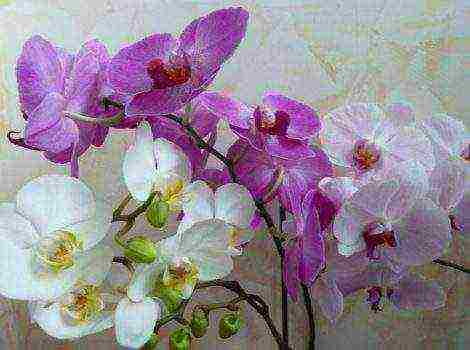Content
The best varieties of tomatoes for the Volgograd region are chosen depending on factors such as the presence of fluctuations in weather conditions and cold springs in the region. Most tomatoes cannot withstand these climatic conditions.
But breeders have created many different hybrid varieties that retain their taste in difficult climatic conditions, do not lose their visual appeal. When choosing tomatoes for the Volgograd region, summer residents and gardeners are best guided by varieties that fully ripen at the end of summer.
What types of plants are the most popular?
Good results are shown by tomato varieties such as:
- Volgograd grade. It is obtained as a result of directed selection. This variety is recommended for novice gardeners, since the plant is unpretentious in care, has a relatively high yield. The fruits of this type are distinguished by their high taste.
- Tomato Fig black. Differs in sweet taste.
- Taimyr tomatoes. A unique plant that can grow in cold seasons.
- Aladdin's lamp. The fruits are colored orange.
- Osiris.
- Moscow delicacy.
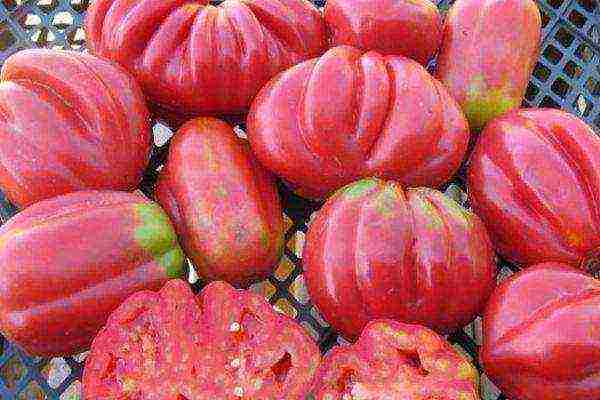
Scientists have determined that early varieties are not suitable for the Volgograd region due to unstable weather in March-April. Although such specimens will grow, some will die due to diseases, and the harvest in the conditions of the region will be small. Bushes with early germination do not have time to gain strength to produce fruits of the required quality and quantity.
The Taimyr variety gives high yields in the form of sweet and strong fruits of small diameter. They grow in a bunch, which is quite unusual for tomatoes.
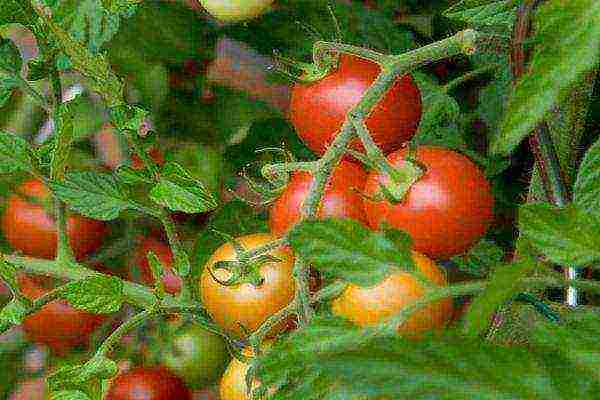
The bushes of the Aladdin's lamp grow up to 200 cm.The fruit has an almost yellow or orange color. Outwardly, it looks like a small pear. Tomato weight - up to 0.3 kg.
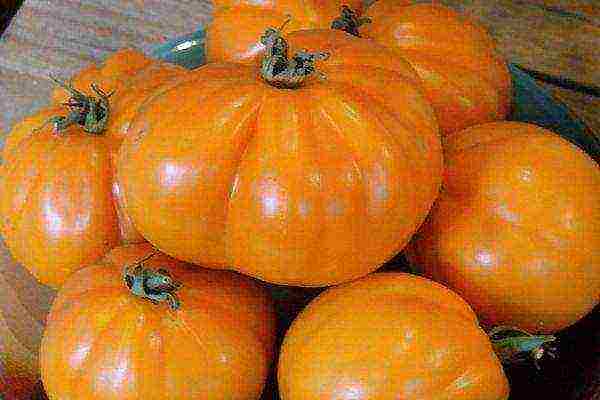
Osiris tomato belongs to high-yielding varieties. On the brush can develop up to 9-10 fruits, burgundy color. Each tomato weighs 50 g.
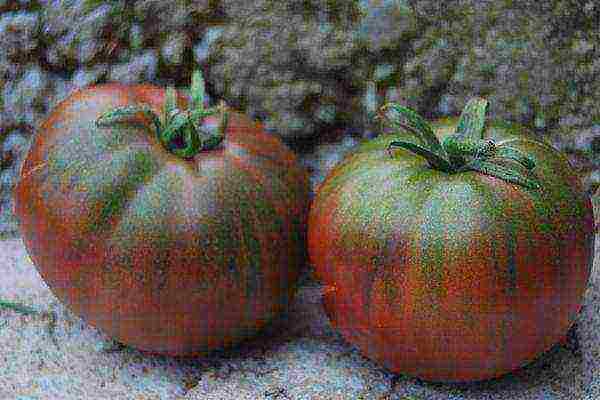
The bushes of the Moscow delicacy can reach 180 cm in height. From each plant, you can get up to 7 kg of yield with an average illumination of the garden. The fruits are elongated.

In addition to the plants described, other types of tomatoes can be grown in the Volgograd region.
What can a resident of the region grow on his site?
Some unusual varieties of tomatoes grow well in the region, for example, Green sweetmeat (also called Chinese surprise). The fruits of this plant have a green-yellow skin. Their flesh is tender, emerald in color. The plant produces crops in mid-summer.
Some summer residents sow the Spaghetti variety. Its fruits look like small, elongated cucumbers. They grow almost simultaneously at the end of the summer season.
The shape of the Lorraine beauty tomato has an unusual shape. If you cut them in half, they will look like a chamomile.
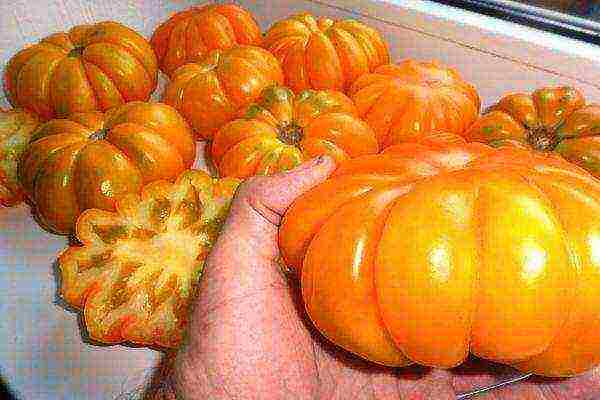
It is best for farmers to plant Dream tomato bushes. This variety is not infected with late blight. Its fruits are of medium size, their weight is about 0.1 kg. They taste sweet and grow together in the middle of summer. There are few seeds inside the pulp. The dream refers to hybrid species that grow well outdoors. Productivity per bush - up to 3 kg.
The Yubileiny Ushakov type has proven itself well. This is a hybrid variety obtained by crossing the Miracle Market and Cherry tomatoes.Yubileiny Ushakov's bush can grow up to 210 cm, grows well in greenhouses. The yield is relatively high: tomatoes cover the stem almost to its entire height. The color of the fruits is red, but they are not larger than a chicken yolk in size.
Plants of this type are well resistant to late blight, withstand sudden cold weather and rainy weather.
All the tomatoes described above can be eaten fresh from the garden. You can make salads, canned fruits for the winter. These types can be processed into tomato paste or juice.
The best type of tomato for the region
The best suited for the conditions of the region is the Volgogradsky variety. The bushes of the plant are low (from 0.2 to 1.0 m). Fruit weight reaches 80-150 g. The plant is resistant to some diseases, such as fusarium. The fruits retain their attractive appearance during long-term transportation.

In total, there are 3 types of these tomatoes:
- The Volgogradsky pink variety ripens in 95-110 days. Has a powerful root system. This is an early ripening type, its fruits weigh up to 0.13 kg. They have a pink color, their shape approaches a sphere. The plant resists a sudden drop in temperature well.
- The early variety Volgogradskiy-323 ripens for 100-105 days. The maximum height of the bushes is about 0.4 m. The fruits have a slight ribbing. They are colored red, and their weight ranges from 80 to 100 g. The yield is average, but the plant resists well such diseases as fusarium and verticillosis.
- Bushes Volgogradskiy 5/95 yield in 120 days. Plant growth does not exceed 100 cm. Fruits are red, weighing up to 150 g. They can withstand long-term transportation.
These plants can easily withstand temperature fluctuations and adverse weather conditions, so they can be grown both in open ground and in greenhouses. Since the number of leaves on the bush is small, the fruits of the plant are well warmed up by the sun's rays.
This type is recommended for novice farmers: regardless of growing conditions, plant productivity remains at the same level. The crop can be stored for a long period. The main thing is that the farmer needs to prepare the beds in the fall by digging up the soil and adding humus mixed with complex mineral fertilizers into it.
It is only necessary to take into account that the soil under the bush must not be allowed to dry out, as this can lead to the development of fungal diseases.... Fertilizing the bushes should be 2-3 times for the entire period of growth.
With the timely loosening of the soil, weeding and other agrotechnical measures, the farmer's harvest is guaranteed.
If pests appear in the garden that can destroy the future harvest, it is recommended to spray the bushes with special medicines.
There are practically no people who would not like fresh ripe tomatoes that have just been picked from the garden. A joy for a summer resident to grow tomatoes in his garden. Especially for those who are especially impatient, The early ripening variety Volgogradskiy 323 and the late ripening variety 5/95 were bred... Description of the variety, features of cultivation in the article.
Tomato Volgograd early ripening pot
One of the most popular varieties of early ripening tomato varieties are non-hybrid varieties Volgogradskiy 323 and 5/95. Variety 323 was bred back in 1973, and variety 5/95 was bred 20 years earlier in 1953.
Description of the variety
Early ripening variety. The bush reaches a height of 45-80 cm, with a large number of leaves and branches, with a peduncle above each leaf or after 2, depending on the species. Surprisingly, the fruits grow to the same size: smooth, round flat. Fruit color is red-orange or pink.
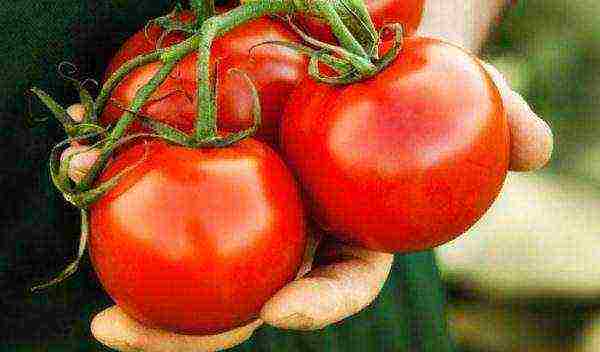 Tomato variety Volgograd
Tomato variety Volgograd
The Volgogradskiy variety is sweet, fleshy, well transported. The plant is unpretentious and amenable to cultivation. Any novice gardener, subject to the instructions for care and cultivation, will be able to grow a rich harvest.
The ripening period of a tomato ranges from 100 to 130 days... Fruits, depending on the type chosen, can weigh from 70 to 150 grams.
The yield reaches from 1 square meter from 4 to 7 kg. The plant is resistant to diseases and tolerates t changes. Prized for a stable harvest.
Volgogradets are versatile in use. It can be preserved, consumed fresh, used for making pasta, mashed potatoes, juices.
a brief description of
- the variety is divided into early and late maturing;
- It has immunity to some diseases;
- carries over drought;
- gives rich harvest;
- has a long shelf life;
- amenable to transportation;
- fetus with juicy pulp.
What is the Difference Between Views 323 and 5/95
To this day, summer residents prefer old varieties of tomatoes, although more and more improved, hybrid varieties appear. Volgograd tomato has 2 types: 323 and 5/95... The difference between these varieties in terms of ripening, color and weight of the fruit.
Grade 5/95
 Late variety of tomato Volgogradskiy 5/95
Late variety of tomato Volgogradskiy 5/95
Is late since after the seeds grow, 120-130 days pass... The color of tomatoes, in the period of full ripeness, acquire a deep red color, and at the base they are green-yellow. Average fruit weight is from 100 to 150 grams. Tomatoes are even, smooth, with juicy pulp. Plant height reaches 80 cm. The crop is formed at a height of 6 leaves and continues every 3 internodes. There are about 6 inflorescences in the brushes of the plant. Tomatoes 5/95 are suitable for any kind of consumption.
Grade 323
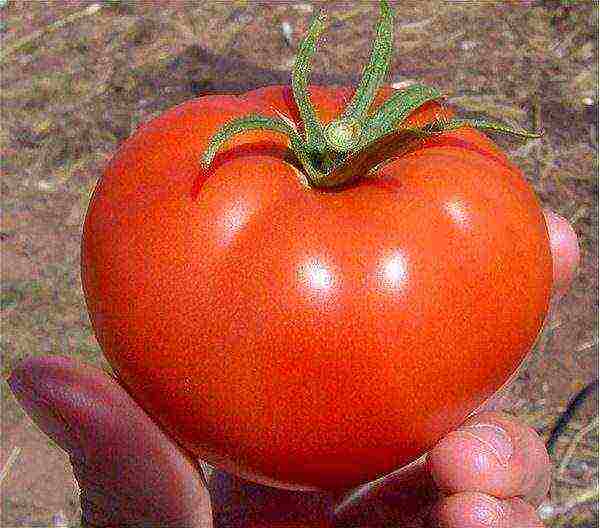 Early ripe tomato variety Volgogradsky 323
Early ripe tomato variety Volgogradsky 323
It is early maturing and can be consumed within 100-110 days. The first crop appears after 90 days, so at the end of June you can already taste delicious tomatoes straight from your garden.
The color of the tomato is red with an orange tint. Average weight 70-80 gr. Although the size of the fruit is small, up to 10 tomatoes grow on one bush. Such an abundance of fruiting occurs due to the formation of nodes under each leaf, starting with the fifth. Unlike variety 5/95, 323 has a low bush up to 45 cm.
Is it true that the varieties are suitable only for the Volgograd region
Rumor has it that the Volgograd tomato is only suitable for growing in the Volgograd region. But this is a misconception.
The tomato is recommended for cultivation in the southern regions because it has the highest yields.
Ideal for Astrakhan, Volgograd, Belgorod, Crimean region, Kuban. In the middle region of Russia, you need to cover the tomato with foil... In the northern strip, this tomato can only be grown in greenhouses, otherwise taste and yield suffer.
Growing features
Before you start growing tomatoes, you need to take care of the correct planting of seedlings, fertilization and watering.
Rules for the formation and planting of seedlings
For growing Volgogradskiy tomatoes, the seedling method is most often used. When the seedling grows up to 15 cm in height, it must be planted in well-heated soil. after the frost has passed and the air temperature reaches 10 degrees and above.
 Volgograd tomatoes are planted with seedlings that are more than 60 days old
Volgograd tomatoes are planted with seedlings that are more than 60 days old
Tomato prefers soil where onions, cabbage or legumes used to grow. Given that the seeds are small, they are buried 5 cm in the ground. Already after 10 days, shoots can be seen. The finished seedlings are planted one bore per area of 30:70 cm.
The plant does not require special care... If necessary, you can feed with fertilizers and pour with warm water. To increase fertility, you can mulch the soil.
Features of planting seeds
Planting time of seedlings: from February to April. The tall variety 5/95 should be sown in February, and the undersized variety 323 should be sown in March. If a Volgograd tomato is sown too early, then a lack of light and a long stay in a cramped pot will negatively affect the appearance of the tomatoes.
Disembarkation rules:
- Recommended before boarding do seed sorting and throw out the damaged and small ones. To increase germination, it is recommended to hold the seeds in a solution of potassium permanganate for half an hour (1 g per 100 ml of water).
- Seedling soil must be nutritious... You can buy it in the store or make it yourself by mixing peat, humus and turf soil.
- The earth must be sifted through a strainer and tamp in containers.
- Plant the seeds to a depth of 3-5 cm at a distance of 3 cm from each other.
- Moisten the soil using a spray bottle and cover the containers with plastic wrap.
- Temperature should be at least +10 e more than +20 degrees.
- If several leaves appear on the seedlings (after 2 months), the plant is ready to be transplanted into larger containers for root development.
Variety reviews
According to gardeners, the variety is outwardly beautiful and excellent for sales, the fruits are large and juicy... Tomatoes grow well, the root system is strong and tolerates the diving process well. Volgograd tomatoes do not get sick with proper care.
What fertilizers are needed
The plant forms stepchildren. They should be removed in order to achieve the formation of a plant into one bush. From the harvested stepchildren, you can prepare an excellent fertilizer for seedlings. For this you need:
- collect stepchildren and fill them with water, leaving for 2 weeks for fermentation;
- after the fermentation process the fertilizer is filtered and diluted with water in a ratio of 1:10.
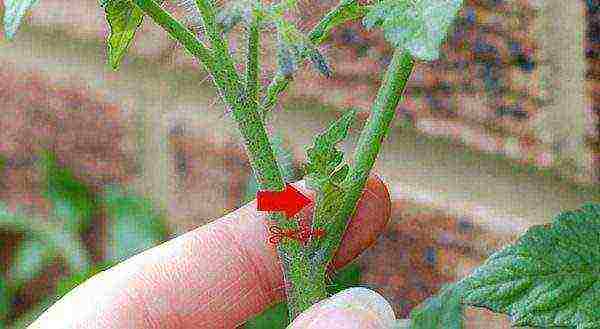 An excellent nitrogen fertilizer can be prepared from removed stepchildren from a tomato bush.
An excellent nitrogen fertilizer can be prepared from removed stepchildren from a tomato bush.
Such fertilizer is considered nitrogen, it is watered with bushes during the flowering period. but the best result can be achieved by feeding the tomatoes with manure or compost... It is also recommended to treat tomatoes for late blight. The drugs can be purchased at a specialist store.
For tomatoes to receive nutrition, they need nitrogen, phosphorus and potassium.
Plants grow well thanks to nitrogen... Therefore, it is recommended to apply top dressing two times: at planting and at the beginning of the formation of ovaries. For fertilization you need: urea, ammonium nitrate, ammonium sulfate, lime.
Phosphorus is responsible for the development of the root system... Fertilizer is applied under the stem and in a perimeter of 40 cm near the bush. Fertilizer: superphosphate or phosphate rock.
Potassium helps tomatoes fight disease... Top dressing is introduced at a time when 3-4 leaves appear on the seedlings. Fertilizers: Potassium monophosphate, potassium nitrate, Kalimagnesia, ash.
Complex fertilizerscontaining all three trace elements: Ammophos, Kristallon.
Disease and pest control
The seeds of the plant are already grafted in advance against most diseases. For prophylaxis against pests and diseases, seeds are disinfected with the help of chemicalsthat are sold in specialized stores. It is also recommended to hold the seeds in a solution of potassium permanganate.
A common disease that affects tomatoes is late blight. Stains form on tomatoes that spread to the flesh of the fruit. To fight the disease, you can use the Zaslon or Barrier sprayers... To do this, take 10 liters of water and add 3 tablespoons of the solution.
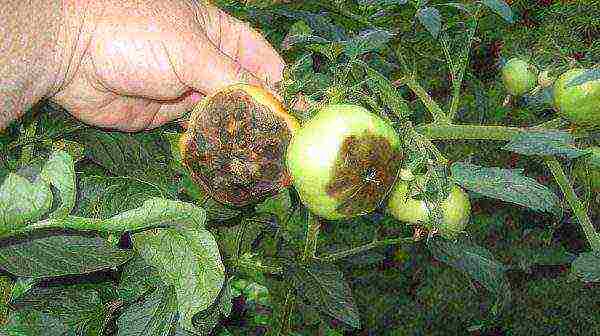 Phytophthora on tomatoes
Phytophthora on tomatoes
Another drug to protect against disease - Oxyhom... Available in tablets. It is necessary to dilute 2 tables. in 10 liters of water. Apply the drug before flowering and at the first signs of the onset of the disease.
Top rot appears due to a lack of moisture in the soil, as well as an excess of calcium and nitrogen. To get rid of the disease, shrubs are sprayed with calcium nitrate.... Infected fruits should be burned.
Tomato Volgogradskiy is the leader among non-hybrid varieties, and all the characteristics described above have been tested by time for many decades.
Other entries about tomatoes
The leaves of tomato seedlings turn yellow. What to do?
Continuing a series of articles about tomatoes of unusual varieties (white and black, green and orange, patterned and velvet), today we will talk about ribbed and long-fruited, which will not only surprise you with their appearance, but also amaze you with their bright ...
Mulching tomatoes is good, hilling is good. How to combine?
On tomatoes, the apical brushes with flowers and buds, as well as leaves, dry up. What to do, please answer !!!
When to start feeding tomatoes? Before planting, organic fertilizers were applied and irrigated with iodine twice.
Hello, friends! I decided to experiment with growing tomatoes on a windowsill. So far, only seeds have been bought (Balcony miracle). I sat there and read different articles in fits and starts, everything was confused in my head. If it's more or less clear about supplementary lighting, then what about ...
See all materials
about tomatoes :
See all
There is no gardener who does not grow tomatoes on his personal garden plot. Everyone has their own favorite variety, tested over the years, which never fails, giving good yields. Despite this, summer residents are not averse to experimenting and planting some novelty worthy of attention on their beds. The Volgograd tomato variety is just that. For some, it has already been tried and loved, while others have never heard of it. This article will introduce readers to the characteristics and characteristics of the variety, and how to grow it in order to get a decent harvest.
Characteristic about the description of the variety
Early ripening variety - Volgograd tomato is truly a godsend for vegetable growers. The compact size of the plants will not take up much space in the greenhouse and on the site. A strong and undersized bush, with a powerful stem, resembles a miniature tree in its appearance. What is important - it does not need to be tied up. It stands well and so, even with many fruits on it. Other varieties of stunted tomatoes are listed here.
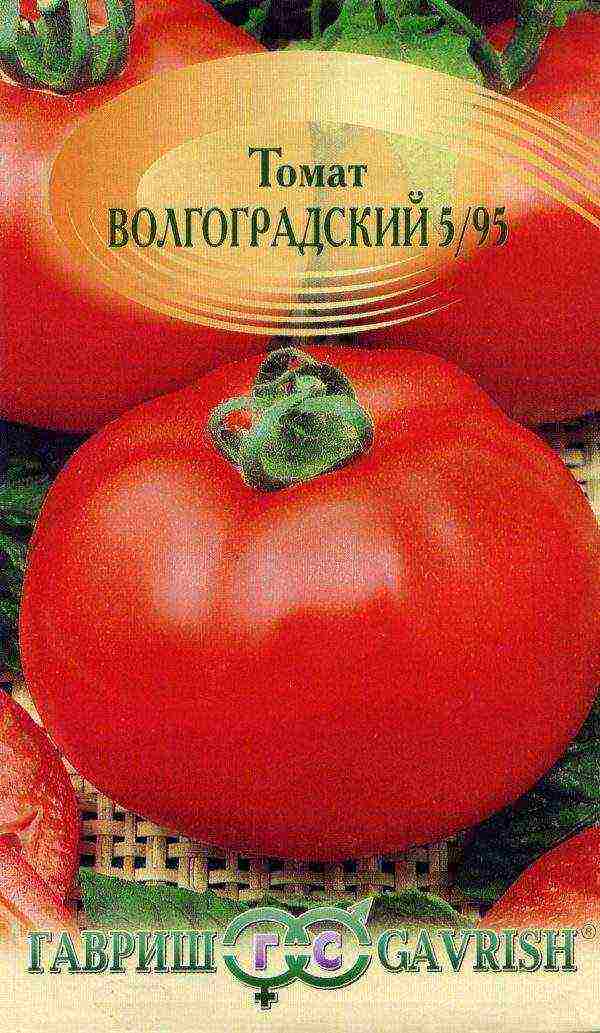 Volgograd tomato seeds can be found in most specialty stores.
Volgograd tomato seeds can be found in most specialty stores.
You can get 7-9 kg of juicy tomatoes from one square meter.
The variety begins to bear fruit in 110 days after the appearance of the first shoots. Suitable for cultivation both under a film shelter and in the open field. Volgograd tomato is a very unpretentious crop that requires minimal maintenance. Due to its determinism, the variety is grown for mass production in huge fields.
Fruit appearance: orange-red tomatoes of regular round shape, medium size, weighing up to 120 g, have excellent taste and high sugar content (up to 3%), which allows them to be widely used for:
- home canning;
- making juice;
- preparation of salads and various sauces.
Similar to the De Barao pink tomato variety in terms of the description and characteristics of the fruit.
 Volgograd tomato has excellent taste and high sugar content. Many farmers note the difference between the taste of tomato juice of this particular variety from the rest.
Volgograd tomato has excellent taste and high sugar content. Many farmers note the difference between the taste of tomato juice of this particular variety from the rest.
The variety is distinguished by a fairly good disease resistance, excellent adaptability to climatic conditions and a consistently high yield, for which it is appreciated by gardeners. Other high-yielding outdoor tomato varieties are described here.
Volgograd tomato tolerates transportation well without losing its appearance and taste. The Valentine tomato variety is endowed with the same qualities.
To preserve the fruits of the variety as long as possible, keep them in a dark and dry place with minimal air humidity.
Country of origin, regions of cultivation
Due to the fact that the tomato perfectly tolerates temperature extremes and dry weather, it can be grown in any region and country. It grows well in all soils and in all climates. In warm regions, tomatoes of this type are planted immediately in open ground, and where the climate is cooler, they are recommended to be planted under a film.
 In cool and cold regions, the Volgograd tomato should be planted under a film to prevent freezing of the shoots.
In cool and cold regions, the Volgograd tomato should be planted under a film to prevent freezing of the shoots.
The optimal regions for cultivating the variety are Astrakhan, Volgograd, Belgorod, Crimean regions, as well as Krasnodar and Stavropol Territories, Ukraine and southern regions of Belarus.
If you want to get a generous harvest of Volgograd tomato, then you need to take care of the correct planting of seedlings, as well as proper care - feeding and watering.
Advantages and disadvantages
From the above, it is possible to summarize all the advantages of the variety:
- high productivity;
- friendly shoots and ripening;
- good disease resistance;
- compactness of plants;
- unpretentious care;
- early maturation;
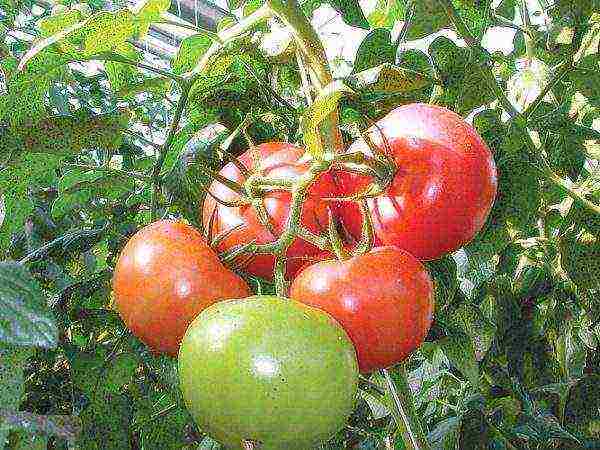 Volgograd tomato variety is early ripening and bears fruit after 110 days
Volgograd tomato variety is early ripening and bears fruit after 110 days
- excellent taste and appearance of the fruit;
- storage duration and transportability;
- resistance to weather conditions;
- versatility of use.
Judging by the reviews of gardeners, there were no shortcomings in the variety.
Growing
Volgograd tomatoes are grown both in greenhouses and in the open field. Usually, these tomatoes are planted by seedling method. In order to grow a good harvest, it is necessary to prepare a garden bed in advance, which is done in late autumn. The earth is dug up and fertilized in the form of humus and minerals. In the spring, the earth is dug up again and ammonium nitrate is added to it. How to prepare the soil for tomatoes in the fall in a greenhouse is described at this link.
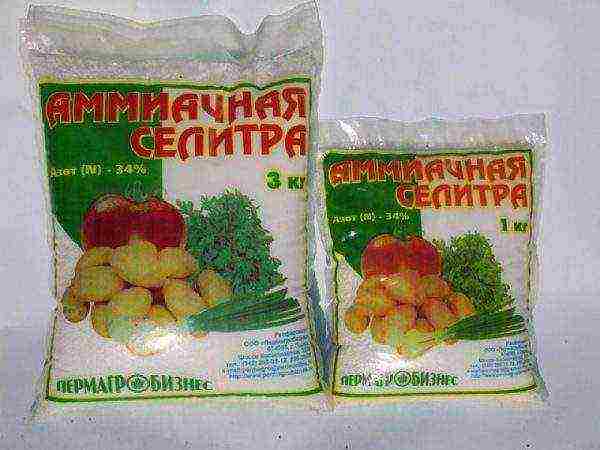 Ammonium nitrate is the best fertilizer for most crops
Ammonium nitrate is the best fertilizer for most crops
Before planting seeds for seedlings, they are soaked for two hours in a weak solution of potassium permanganate, and then washed with water. For sowing, take specially prepared soil, which can be purchased in specialized stores.
For sowing seeds, wooden boxes are used. The sowing depth should not be more than 2 cm, otherwise the sprouts will not be able to hatch. The distance between the seeds is 3 cm. Water the plantings with warm water and cover with foil. Drawers are put away in a dark and warm place. As soon as shoots appear, and this happens somewhere in a week, the film is removed, and the containers with seedlings are placed in a bright place. If the weather is cloudy, artificial lighting will be required for seedlings.
After the appearance of 5-7 strong leaves, the seedlings must be dived into separate pots. 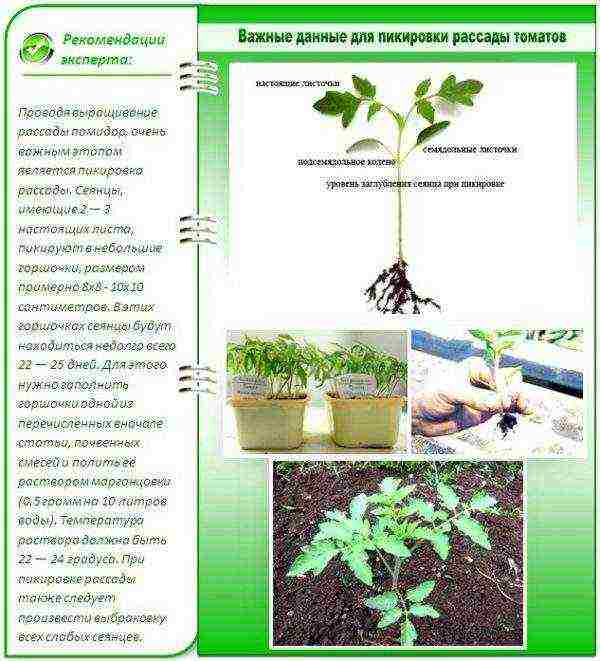
Seeds are sown for seedlings, usually in March - April, depending on where the plants will be planted - in a greenhouse or open ground. The sowing time is chosen in accordance with the lunar sowing calendar for tomatoes.
Tomatoes will grow well in those places where zucchini, beans, carrots, peas, cabbage, cucumbers grew a year earlier.
In the open field
Seedlings are planted in open ground 30-45 days after the emergence of sprouts, as soon as the threat of night frosts has passed. This usually happens in early June. In order for the plants to take root as much as possible, they are taken out into the open air in advance, each day increasing the duration of their stay on the street.
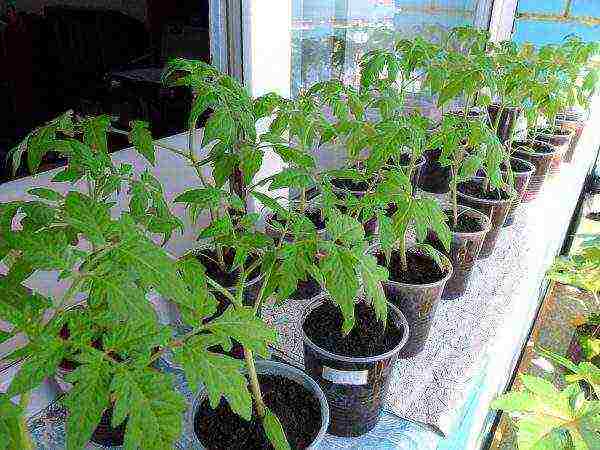 Seedlings begin to grow at home in early spring.
Seedlings begin to grow at home in early spring.
Seedlings are planted on the beds according to the 50x70 scheme, adding nitrogen-containing fertilizer to the prepared holes, as well as a handful of wood ash, which will protect them from decay and saturate the soil with minerals.
It is recommended to mulch the soil around the roots of tomato bushes with sawdust to make it easier to care for them.
Plants are watered abundantly, every 10 days, early in the morning or after sunset to prevent sunburn.
Care also consists of pinching tomatoes and feeding. If a small number of ovaries form on the plants, they should be fed with urea. Also, to achieve high yields, organic fertilizers should be applied - last year's manure and compost.
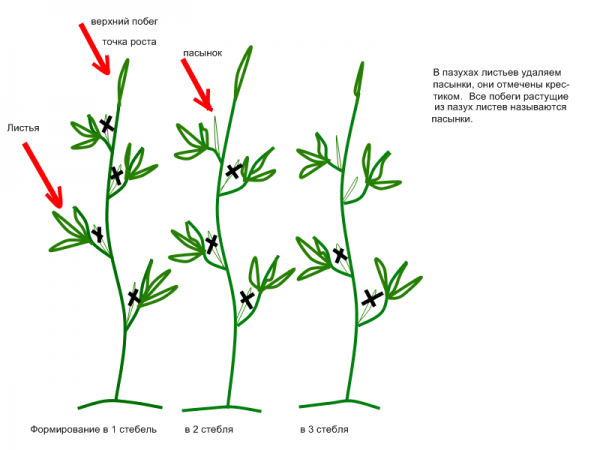 The stepchildren are harvested early in the morning, leaving small shoots so that the branch does not grow again.
The stepchildren are harvested early in the morning, leaving small shoots so that the branch does not grow again.
After cutting off, stepchildren do not need to be thrown out. An excellent fertilizer can be prepared from them. To do this, they are put into a barrel and filled with water, where the waste ferments for 2-3 weeks.Then the solution is filtered and diluted with water 1:10. This fertilizer is used as a top dressing before flowering.
In greenhouses
Seedlings are planted in greenhouses in the same way as in open ground, but a little earlier - in May. The principle of planting and leaving is the same. The only thing to do is to open the greenhouse in hot weather so that the plants are not cooked from the heat. Growing tomato seedlings at home is described in this material.
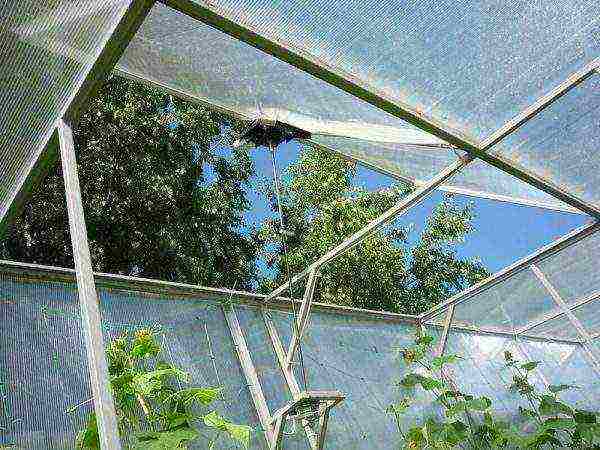 It is very important to ventilate the greenhouse, but it must be borne in mind that tomatoes do not like drafts.
It is very important to ventilate the greenhouse, but it must be borne in mind that tomatoes do not like drafts.
This is also done in order to provide access to tomato bushes for pollinating insects when the plants begin to bloom. More about
Watering under a film cover is carried out a little more often - once every seven days.
Yield
The first fruits on the bushes can appear as early as 90 days after germination. Volgograd tomato bears fruit very well. Up to 8 kg of fruits are harvested from 1 square meter. With good care, one plant produces about 6 kg of tomatoes. The variety is characterized by the amicable appearance of ovaries, from which juicy tomatoes appear and ripen almost simultaneously. This fact allows the variety to be widely used for commercial purposes, that is, for sale.
 Productivity reaches up to 8 kilograms per square meter Diseases and pests
Productivity reaches up to 8 kilograms per square meter Diseases and pests
In general, this type of tomato is resistant to diseases and pests. He practically does not get sick with veritzillosis, leaf spot, mosaics, but there is a possibility of damage to root and gray rot, especially at high humidity and air temperatures above +29. If the seeds were purchased from a store, then most likely they have already been treated for disease. However, it is better to play it safe and carry out preventive disinfection without waiting for the bushes to get sick. For this, young plants are treated with phytosporin or a pinkish solution of potassium permanganate.
 Every gardener should have this biofungicide. Fitosporin is a very cheap and widely available drug
Every gardener should have this biofungicide. Fitosporin is a very cheap and widely available drug
Spraying with insecticides will save from insect attacks, which will completely destroy the whitefly, spider mites and thrips. An aqueous solution of laundry soap will relieve aphids.
If there is a suspicion of plant damage by phytosporosis, tomatoes should be sprayed with preparations containing copper.
Video
conclusions
Despite some troubles accompanying the cultivation of the Volgograd tomato, gardeners are happy to cultivate it in their summer cottages. The variety has shown itself to be fruitful and hardy, and the excellent taste and quality of the fruits for many years delight us with their presence on our tables, especially if the juicy tomatoes were grown by our own hands.
The features of growing tomatoes in a greenhouse are described in detail in this article.


